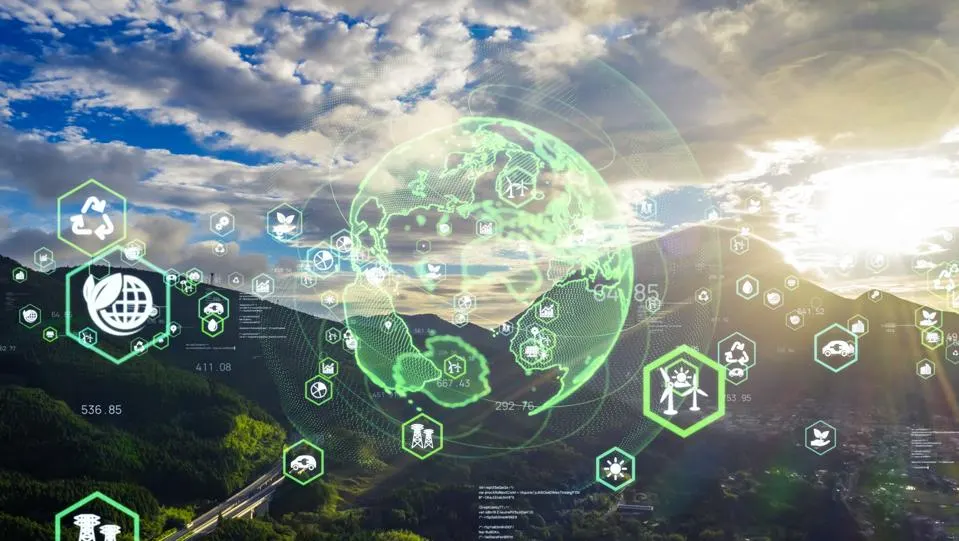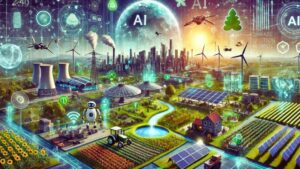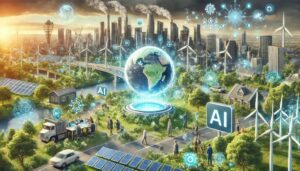Climate and Eco-Driving AI: A Sustainable Path to Greener Mobility
Introduction
Transportation is one of the largest contributors to greenhouse gas (GHG) emissions worldwide, responsible for nearly a quarter of global CO₂ emissions. The sector is dominated by fossil fuel-powered vehicles, but even with the rise of electric vehicles (EVs), the challenge of sustainability persists. As climate change intensifies, governments, industries, and individuals are seeking innovative ways to reduce emissions, improve energy efficiency, and create greener mobility solutions.
One promising approach is the integration of Artificial Intelligence (AI) in eco-driving systems. Eco-driving AI refers to the use of machine learning, predictive algorithms, and real-time data analytics to optimize driving behavior, fuel efficiency, and vehicle performance. By combining climate-conscious policies with intelligent driving technologies, eco-driving AI could play a central role in mitigating transportation’s impact on the planet.
This article explores the intersection of climate change and eco-driving AI, highlighting its role in reducing emissions, its applications in everyday driving, and its potential to shape a more sustainable future.
Climate Change and Transportation: The Urgency
Climate change is no longer a distant threat—it is a present crisis. Rising global temperatures, melting polar ice, and extreme weather events are direct consequences of increasing greenhouse gas concentrations in the atmosphere. The transportation sector remains one of the hardest to decarbonize due to its dependence on petroleum-based fuels.
Key facts:
-
Road transport accounts for nearly 75% of transport-related CO₂ emissions globally.
-
Passenger cars alone contribute over 40% of these emissions.
-
Even though EV adoption is rising, over 1.4 billion internal combustion engine (ICE) vehicles are still on the road.
While electrification is a long-term solution, immediate actions are needed to reduce emissions from existing vehicles. This is where eco-driving strategies powered by AI can have a significant impact.
What is Eco-Driving AI?
Eco-driving traditionally refers to driving practices that minimize fuel consumption and reduce emissions. Techniques such as smooth acceleration, avoiding unnecessary idling, maintaining steady speeds, and anticipating traffic conditions can save up to 15–20% of fuel.
With the rise of AI, these strategies are becoming more intelligent and automated. Eco-driving AI systems leverage:
-
Machine Learning (ML): Algorithms learn from driver behavior, traffic patterns, and environmental conditions.
-
Predictive Analytics: AI anticipates road congestion, elevation changes, and optimal routes.
-
Real-Time Monitoring: Sensors and telematics track fuel consumption, speed, braking, and acceleration.
-
Adaptive Feedback: AI provides drivers with suggestions or automatically adjusts vehicle functions to improve efficiency.
By embedding AI into vehicles, navigation systems, and traffic infrastructure, eco-driving moves from a manual choice to a seamless, technology-driven experience.
Applications of Eco-Driving AI
1. Intelligent Driver Assistance
Modern vehicles equipped with AI-based driver assistance systems can guide drivers toward more eco-friendly behaviors. For instance, systems may suggest:
-
Shifting gears at optimal RPM.
-
Avoiding aggressive braking or acceleration.
-
Maintaining the most fuel-efficient cruising speed.
Some advanced systems even provide gamified eco-driving scores, encouraging drivers to compete with themselves to drive more efficiently.
2. Route Optimization
AI-powered navigation tools can calculate the greenest route, considering:
-
Real-time traffic congestion.
-
Terrain and elevation.
-
Road conditions and speed limits.
For example, a route that is slightly longer but avoids steep inclines or heavy traffic may reduce fuel consumption and emissions significantly.
3. Fleet Management
For logistics and ride-hailing companies, eco-driving AI can dramatically reduce operational costs and carbon footprints. AI systems track driver behavior, fuel efficiency, and vehicle maintenance schedules, offering insights into:
-
Reducing idle times.
-
Optimal load management.
-
Predictive vehicle servicing to prevent inefficiencies.
4. Electric Vehicle (EV) Efficiency
For EVs, eco-driving AI helps optimize battery usage. By predicting energy demands based on route and driving behavior, AI ensures maximum range and prevents unnecessary energy drain.
5. Smart Cities Integration
When integrated into smart city infrastructure, eco-driving AI can communicate with traffic lights, road sensors, and weather systems. This connectivity ensures smoother traffic flow, reduced congestion, and less energy wasted in idling vehicles.
Benefits of Eco-Driving AI
1. Climate Impact
By reducing fuel consumption and improving efficiency, eco-driving AI contributes directly to lowering CO₂ and other greenhouse gases. Even a 5–10% improvement in fuel efficiency across global road transport could result in a massive reduction in emissions.
2. Cost Savings
For both individuals and businesses, eco-driving translates into financial savings. Lower fuel consumption, optimized maintenance, and fewer mechanical breakdowns reduce overall expenses.
3. Enhanced Safety
Eco-driving promotes smoother driving patterns, reducing the likelihood of accidents caused by aggressive driving behaviors such as sudden braking or rapid acceleration.
4. Extended Vehicle Lifespan
By minimizing wear and tear on engines, brakes, and tires, AI-driven eco-driving extends the life of vehicles and reduces waste generated from scrapped parts.
5. Behavioral Change
AI-driven feedback nudges drivers toward long-term sustainable habits, creating a culture of environmental responsibility in transportation.
Challenges of Eco-Driving AI
While the potential is immense, eco-driving AI also faces several challenges:
-
Adoption Resistance: Many drivers may resist changing their driving behavior, even with AI assistance.
-
Data Privacy: Real-time monitoring and telematics raise concerns about data collection and personal privacy.
-
Cost of Implementation: Advanced eco-driving systems may be costly, limiting adoption in low-income regions.
-
Infrastructure Dependency: Full potential requires integration with smart city infrastructure, which is still in early development stages.
-
Unintended Consequences: Over-reliance on AI assistance could reduce driver attentiveness in some cases.
Case Studies: Eco-Driving AI in Action
Google Maps Eco-Friendly Routing
In 2021, Google introduced an AI-driven eco-routing feature in Google Maps. It suggests routes that minimize fuel or energy consumption based on traffic, terrain, and road conditions. Millions of drivers worldwide now benefit from lower emissions and fuel savings without changing their navigation habits.
Toyota’s Eco-Driving Feedback Systems
Toyota’s hybrid vehicles feature real-time eco-driving feedback, offering drivers visual cues and scores on efficient driving. This gamification approach has proven effective in encouraging long-term behavioral change.
UPS Route Optimization
UPS, the global logistics giant, uses AI-based routing software (ORION) to minimize unnecessary turns, idle times, and mileage. By cutting millions of miles driven annually, UPS saves millions of gallons of fuel and significantly reduces its carbon footprint.
The Future of Eco-Driving AI
The evolution of eco-driving AI is closely tied to broader advances in autonomous vehicles, IoT, and sustainable energy systems. Future developments may include:
-
Autonomous Eco-Driving: Self-driving cars will inherently optimize acceleration, braking, and routing for maximum efficiency.
-
Vehicle-to-Everything (V2X) Communication: Cars will communicate with traffic lights, other vehicles, and city infrastructure to reduce congestion.
-
AI-Powered EV Charging: Intelligent systems will align EV charging with renewable energy availability, minimizing carbon intensity.
-
Integration with Carbon Tracking Apps: Drivers may receive direct insights into their personal carbon footprint, encouraging greener lifestyle choices.
As global climate goals tighten, eco-driving AI will likely shift from being an optional feature to a mandatory part of sustainable mobility strategies.
Conclusion
Climate change is the defining challenge of our era, and the transportation sector stands at the heart of the problem. While electrification and renewable energy are long-term solutions, eco-driving AI provides a practical, immediate, and impactful strategy to reduce emissions from billions of vehicles already in use.
By optimizing driving behavior, integrating with smart infrastructure, and leveraging AI innovations, eco-driving AI not only lowers carbon footprints but also delivers financial, safety, and societal benefits. From individual drivers to global logistics companies, the adoption of eco-driving AI is a vital step toward sustainable transportation.
As technology continues to advance, eco-driving AI will evolve from assisting drivers to autonomously shaping entire transport ecosystems—leading us closer to a greener, smarter, and climate-resilient future.
https://bitsofall.com/https-yourwebsite-com-biological-interactions-the-web-of-life/
AI Meets Game Theory: Transforming Social Scenarios with Intelligent Decision-Making
AI in Astrophysics: How Artificial Intelligence is Unlocking the Secrets of the Universe







